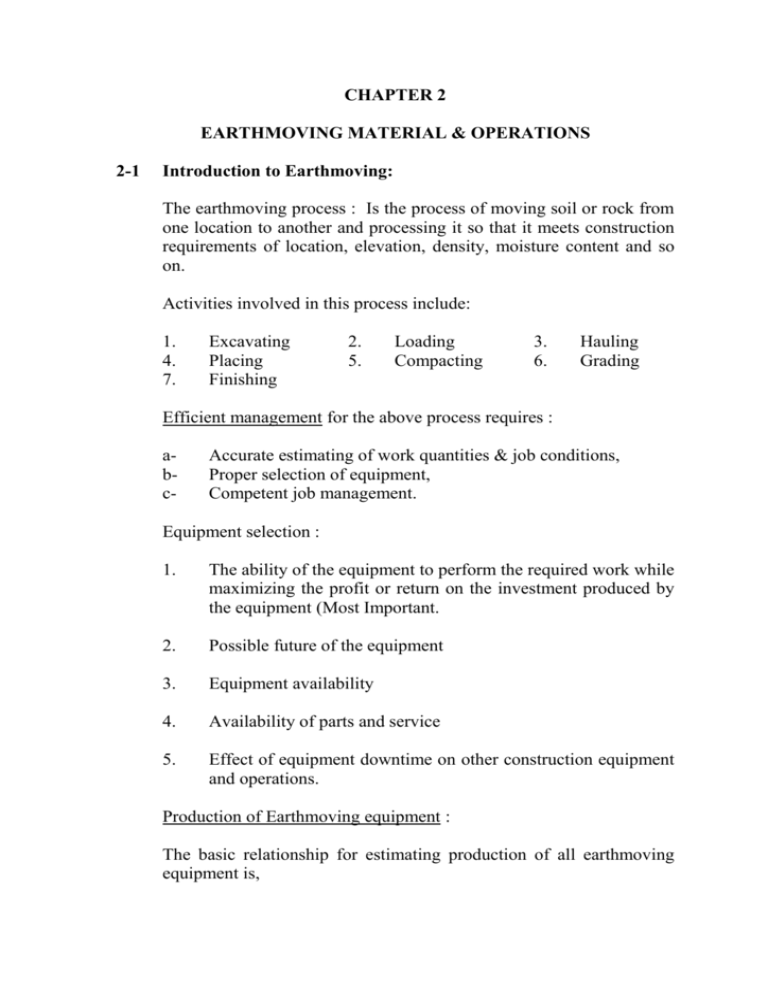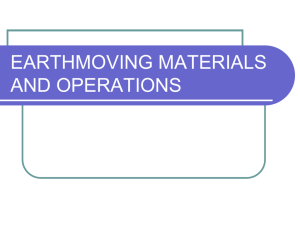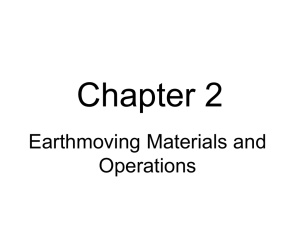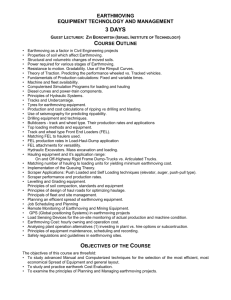CHAPTER 2
advertisement

CHAPTER 2 EARTHMOVING MATERIAL & OPERATIONS 2-1 Introduction to Earthmoving: The earthmoving process : Is the process of moving soil or rock from one location to another and processing it so that it meets construction requirements of location, elevation, density, moisture content and so on. Activities involved in this process include: 1. 4. 7. Excavating Placing Finishing 2. 5. Loading Compacting 3. 6. Hauling Grading Efficient management for the above process requires : abc- Accurate estimating of work quantities & job conditions, Proper selection of equipment, Competent job management. Equipment selection : 1. The ability of the equipment to perform the required work while maximizing the profit or return on the investment produced by the equipment (Most Important. 2. Possible future of the equipment 3. Equipment availability 4. Availability of parts and service 5. Effect of equipment downtime on other construction equipment and operations. Production of Earthmoving equipment : The basic relationship for estimating production of all earthmoving equipment is, Production = Volume per cycle Cycles per hour Cycle per hour must include appropriate efficiency factor. - Manufacturers provided charts or tables for estimating the production of their equipment. - The cost per unit of production may be calculated as follows: Cost per unit of production Equipment cost per hour Equipment production /hour There are two principle approaches to estimating job efficiency in determining the number of cycle per hour. 1. to use the number of effective working minutes per hour to calculate the number of cycles achieved/hour. 2. to multiply the number of theoretical cycle per 60-minutes hour by a numerical efficiency factor by using Table 2-1 of Textbook. 2-2 Earthmoving Materials: General soil characteristics: Trafficability : The ability of a soil to support the weight of vehicles under repeated traffic. Loadability : A measure of difficulty in excavating and loading the soil. Unit weight of soil is normally expressed in pounds per Cubic yard or Kg/CM and it depends on * Soil type * Moisture content * Degree of compaction Moisture content of a soil is expressed as a percentage that represents the weight of water in the soil divided by the dry weight of the soil. Moisture content (%) 2-3 Moist weig ht - Dry weight 100 Dry weight Soil Volume - Change Characteristics : There are three principle conditions or states in which earthmoving material may exist : bank, loose, compacted. * Bank : Material in its natural state before disturbance. Often referred to as "in-place" or "in situ". Bank cubic yard (BCY) or Bank cubic meter (Bm3) * Loose : Material that has been excavated or loaded. Loose Cubic yard (LCY) or Loose Cu. Meter (Lm3). * Compacted: Swell : Material after compaction. Compact Cubic Yard (CCY) or Compacted Cubic Meter (Cm3). A soil increases in volume when it is excavated. This is called swell. Swell is calculated as, Weight / Bank volume Swell (%) 1 100 Weight/Loo se volume Example:Find the swell of a soil that weighs 2,800 LB/Cu.Yd in its natural state, and 200 Lb/Cu.Yd after excavation. Solution: 2800 Swell 1 100 40% 2000 i.e. 1 bank cubic yard of material will expand to 1.4 loose cubic yards after excavation. Shrinkage : When a soil is compacted, it will occupy less volume than it did under either the bank or loose conditions. Shrinkage is calculated as: Weight/ban k volume Shrinkage (%) 1 Weight/com pacted volume 100 Note that both swell and shrinkage are calculated from the bank (or natural) condition. Volume changes are illustrated in Figure 2-2. Example : Find the shrinkage of a soil that weighs 2,800 Lb/Cu yard in its natural state & 3,500 Lb/Cu yard after compaction. Solution : 2800 Shrinkage 1 100 3500 = 20% Hence, 1 bank cubic yard of material will shrink to 0.8 compacted cubic yard as a result of compaction. LOAD AND SHRINKAGE FACTORS : All material volume should be converted to a common unit of measure such as : BCY or Bm3 (Bank), LCY or Lm3 (Loose), CCY or Cm3 (Compacted) A pay yard (or meter) is the volume specified as the basis for payment in any earthmoving contract. It may be any of the above three volumes. - Because haul unit and spoil bank volume are commonly expressed in loose measure, therefore it is convenient to have a conversion factor to simplify the conversion of loose volume to bank volume. The factor used for this purpose is called Load Factor. Load factor Weight/loo se unit volum e Weight/ban k unit volum e Load factor 1 1 Swell Loose volume is multiplied by the load factor to obtain bank volume. To convert bank volume to compacted volume a shrinkage factor is used. Shrinkage factor Weight/ban k unit volum e Weight/com pacted unit volum e Shrinkage factor = 1 Shrinkage Bank volume Shrinkage factor = Compacted Volume, OR Compacted volume Shrinkage factor = Bank volume. 2-4 Spoil Banks It is important to determine the size of the pile of material that will be removed by excavation. There are two types of material: 1- Spoil Banks : It is a pile of material where the length is more than its width and it is characterized by a triangular cross section. 2. Spoil pile : It is a pile which has a conical shape. To determine the dimensions of spoil bank or pile, first convert the volume of excavation from in-place (BCY or Bm3) to loose conditions (LCY or Lm3); bank or pile dimensions may then be calculated by using the following equations: 2-5 Soil Identification & Classification : Fundamental Soil Types : Gravel : > ¼" (0.6mm) but < 3" (boulders) Sand : > No. 200 sieve but < ¼" Silt : < No. 200 sieve but > 0.002 mm Clay : < 0.002 mm Organic soils : Contain partially decomposed vegetable matter. Soil Classification systems : * Unified system * AASHTO system (Table 2-4) (Table 2-5) - Liquid Limit (LL) : is the water content (% of dry weight at which the soil will just start to flow when subjected to a standard shaking test. - Plastic Limit (PL) : is the moisture content at which the soil just begins to crumble when rolled into a thread 1/8" in diameter. - Plasticity Index (PI) : is the numerical difference between the liquid and plastic limits and represents the range in moisture content over which the soil remains plastic. Field Identification of Soil : The procedure described in the test (extracted from the unified system) is very adequate for quick field identification of soils. Construction Characteristics of Soils : Table 2-6 summarizes some important construction characteristics of soils as classified under the unified system.










